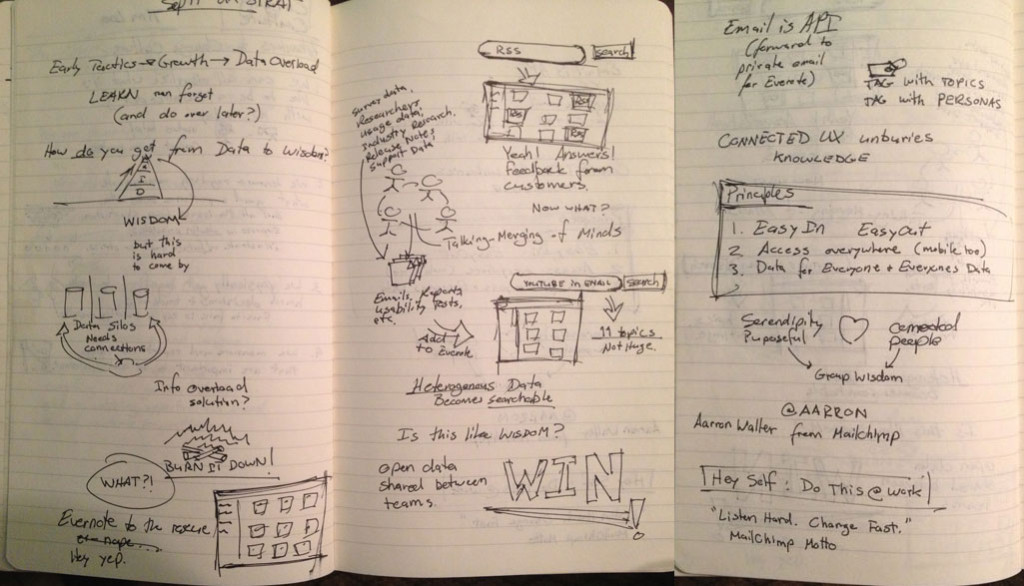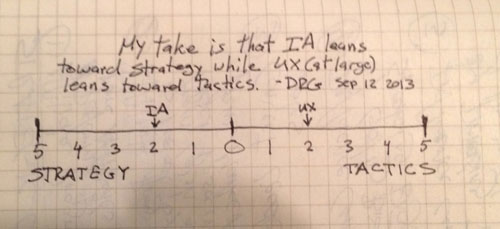I just wrapped up the day by having dinner with Simon of Bristol (okay, Simon Norris of Nomensa) and Bob Royce and Dan Klyn of The Understanding Group. A relaxed conversation with three brilliant gentlemen—an excellent end to the day.
So, the conference. First, I was glad to have met Josh Seiden in person so that I could apologize for my choice words about Lean UX in the preceding blog post. Josh is legit.
As for the topics, again, too many for me to itemize, so I’ll first do a top-of-mind review and then think about themes.
Top-of-mind reflections
First, Aarron Walter of MailChimp blew me away with the approach he shared about using Evernote with e-mail as basically an API to take a very real step at solving the data silos problem. Sure, this may not have been pure strategy, but as a tactic, wow. Thank you Aarron.

Heads-up to my team, we’re going to give this a whirl.
Second, Ronnie Battista had the whole room laughing repeatedly. Awesome presentation style, and great ideas on “The Ten Commandments of UX Strategy.” (Where is our Hippocratic Oath?)
Okay, there you go for top-of-mind.
What was missing?
So, back in the late 1990s I thought of information architecture as something akin to strategy, and we didn’t have the label “user experience.” (At least if we did, I was still too ignorant.) Then IA lost its way amidst all the insane growth of the web, related technologies, and professions. (Yep, I’m over-simplifying history.) I stopped thinking of myself as an information architect and eventually replaced my self-identity with user experience.
Then a few years ago a new generation of information architects began to speak, and among them is Dan Klyn. Dan and his cohort have knelt around the dying embers of information architecture and breathed life back into it, adding tinder, twigs, wood.
IA is starting to throw off heat and light again, and thank goodness for that.
And you know what? This new framing of information architecture looks even more like strategy to me. Now, it isn’t strategy any more than design is strategy—but they overlap in meaningful ways.
Let me put it this way, if I had a performance continuum describing information architecture with one end called strategy and the other tactics, I’d probably describe IA by putting a mark halfway to strategy. (Is that “strategy yet tactics?”) If I used the same continuum to describe UX, I would regretfully right now put the mark on the half towards tactics.

So, whether IA and UX are cooperative siblings or one contains the other (or they overlap, but not fully), UX strategy seems to me like it ought to sit down and listen hard to what today’s information architects are doing.
Or, hey, maybe we as a UX strategy tribe think that “good” is tactical, yet strategic, not the other way around. Seriously.
(End of that editorial.)
Themes from Day 2
We need data. We need to get it and use it. It is part of the language of business.
Stories and data together can be compelling.
We need to continually adapt UX strategy to corporate strategy in order to stay relevant to the business.
We need to be ambassadors, reaching out to our partners within our businesses. Seek to understand them, even serve them, and build those connections.
Learning is part of culture. We need to continually learn. Be bold in being okay with change (think of Dick Fosbury and how he changed how the high jump is done).
The DIKW pyramid, getting to Wisdom is hard!
UX strategy includes shaping our teams capabilities in ways that will best serve the business.
Customer Experience is often populated with marketing professionals. Are they a group to compete with or a group to align with? Should we just admit we’re all doing the same thing, only that we’ve been doing it longer? Or is there really a difference?
UX strategy does include organizational change (overlapping with changes to an organization’s culture). Think the Vistaprint center for excellence, the innovation program at Citrix, and the leadership changes at Sage over a few years.
Done
And, I’m spent. It’s been said, but can be said again: UX STRAT team, fantastic job. Thank you for all your time and effort. It was worth it.

